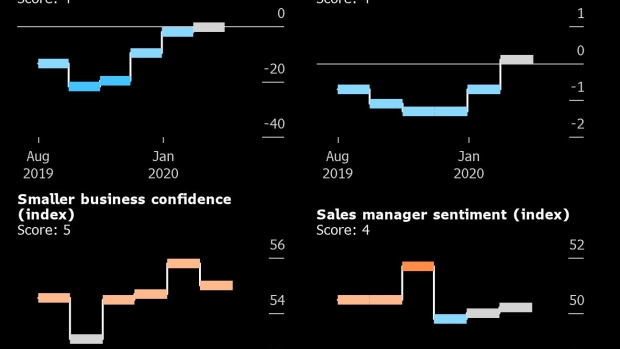Jan 23, 2020
China’s Economy Was Brightening This Month Before Virus Fear Hit
, Bloomberg News

(Bloomberg) -- The latest available indicators of China’s economy signal improving conditions in January, though that recovery is at risk from the fallout from the worsening Wuhan pneumonia outbreak.
The eight indicators tracked by Bloomberg show signs of improvement in trade, prices and companies, building on the stabilization in overall growth seen last quarter.
Retail sales, investment and industrial output all were stable or improving in December, providing a brighter end to a year when the economy struggled under the weight of a crackdown on debt, weak demand and the trade war. With transport to the central hub city of Wuhan now locked down and consumer activity curtailed nationwide for fear of infection, the disease poses an as-yet-unquantifiable hazard to the broader positive trend.
“If the lockdown continues after the Lunar New Year holidays, it will affect industrial production, one of the key growth drivers,” Raymond Yeung, chief Greater China economist at Australia & New Zealand Banking Group in Hong Kong, wrote in a note.
The signing of the phase-one trade deal with the U.S., combined with recovering global demand, had improved the outlook for Chinese factories and exporters in 2020, though uncertain implementation of that deal and domestic financial fragility remain risks.
In the early indicators, the broader macroeconomic data have mostly been pointing up, with South Korean exports in the first 20 days of January basically unchanged, after falling for all of 2019. South Korean companies such as Samsung Electronics Co. supply critical tech components and trade across Asia, so that timely data is seen as a good leading indicator of activity across the region.
The pickup in factory prices in China is also a good sign, as it indicates that demand is improving and should also lead to an increase in company profitability. Although the headline index on small business confidence dropped in January from December, the rise in output prices should boost profit margins, according to Standard Chartered Plc, which compiles the data on small enterprises.
“There are signs of restocking, with companies increasing their raw material inventory, which bodes well for future production activity,” according to Lan Shen and Ding Shuang, economists at Standard Chartered Bank Ltd. “Confidence in export-oriented SMEs has been boosted by the U.S.-China trade truce and improving external demand, which could result in better trade performance.”
With the Lunar New Year break starting Friday in China, business activity was likely to be slow in the second half of the month. The surprisingly strong industrial output and retail sales data in December may have been partly due to companies and consumers producing and buying more then in advance of the break.
Since then, the pneumonia outbreak which began in Wuhan has undercut the stock market rally which took off in December on the announcement of a trade deal and signs the economy was stabilizing. The CSI 300 gauge of stocks in Shanghai and Shenzhen is now back where it was just after China and the U.S. announced the initial trade deal in mid-December.
The reaction to the increasingly severe outbreak may also not be reflected in the Purchasing Manager Indexes for January, which will be released at the end of this month. Usually, the surveys for those take place between the 20th and 25th of each month, but due to the holiday they were conducted this year between Jan. 15 and Jan. 20, according to the National Bureau of Statistics. That was before the extent of the disease was well understood.
Note on Early Indicator construction
Bloomberg Economics generates the overall activity reading by aggregating the three-month weighted average of the monthly changes of eight indicators, which are based on business surveys or market prices.
- Major onshore stocks - CSI 300 index of A-share stocks listed in Shanghai or Shenzhen
- Key property stocks - All the constituents of CSI 300 Index that are in the real-estate industry
- Iron ore prices - Spot price of iron ore for shipment to Qingdao port (dollar/metric tonne)
- Copper prices - Spot price for refined copper in Shanghai market (yuan/metric tonne)
- South Korean exports - South Korean exports in the first 20 days of each month
- Factory inflation tracker - Bloomberg Economics created tracker for Chinese producer prices
- Small and medium-sized business confidence - Survey of companies conducted by Standard Chartered Bank
- Sales manager sentiment - Survey of sales managers in Chinese companies by World Economics Ltd.
To contact Bloomberg News staff for this story: James Mayger in Beijing at jmayger@bloomberg.net
To contact the editors responsible for this story: Jeffrey Black at jblack25@bloomberg.net, John Liu
©2020 Bloomberg L.P.


